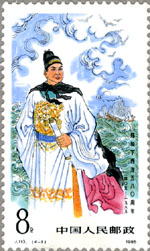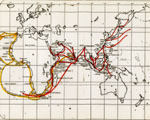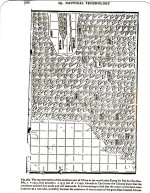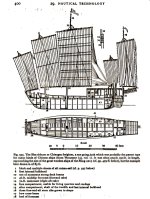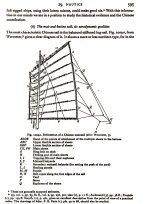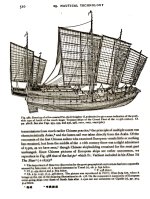
The Comparative Uses of Power: China on the African Rim and the United States on the Pacific Rim
Seventh George Bancroft Memorial Lecture, United States Naval Academy, Annapolis, Maryland. September 30, 1986.
[Author's Note. This is an essay, rather than a mini-monograph, although it is based upon extensive research in primary and secondary sources. I am particularly indebted to Joseph Needham and his associates at Cambridge University. I also learned much from Phyllis Tolstoy who, during a year's residence at the Chinese Institute of Oceanography in Shandong, took the time to explore the records about Admiral Zheng He (including recently discovered documents by Huang Shengceng). Beyond my own researches, I have found G. V. Scammell's approach to Western deployment of power, The World Encompassed, a learned and candid reference point. Later, I was engaged and stimulated by Richard Rosecrance's The Rise of the Trading State: Commerce and Conquest in the Modern World.]
My purpose is to define and reflect upon the comparative development and deployment of the first intercontinental missiles, in particular, the great ships of the open sea launched by China and the West (especially the United States). My concern is less to persuade you of my particular views than to engage you to undertake your own voyages of exploration into the far reaches of the issues I will raise.
I offer these reasons for using the modern idiom of intercontinental missiles to describe a much earlier technology. First, it is accurate. Second, it serves to remind us that Progress is an illusive, if not a mocking, Goddess. Third, it helps to dramatize the question of the purposes for which such technology has been used, is used, and should be used.
I am working with this definition: an intercontinental missile is a vehicle capable of transferring goods, ideas, values, and people from one continent to another without recourse to overland transport. Such a missile is an especially potent instrument for the projection of power. Marco Polo made that point when he reported that in 1290 (or 1292?) he was returned from China in a convoy of 14 "great ships, every one of them having four masts.... [And] in every ship there were 600 men, and provisions for two years."
Until very recently, however, and even largely today, most Western historians have presented the development and deployment of such intercontinental missiles as the special achievement of Western European genius. This is history at its ethnocentric worst. Phoenicians reached England, and very probably circumnavigated Africa, before the properly certified Western Europeans managed to escape the great lake known as the Mediterranean. And the Arabs built better ships with far more sophisticated sails - and reached India and China - long before Prince Henry the Navigator created his school of oceanography at Sagré. Indeed, the graduates of Henry's academy needed an Arab navigator to guide them to India.
Such facts carry us beyond the issue of how Western racism has fostered and institutionalized ignorance. Define the comparison this way: Bartholomew Diaz reached the Cape of Good Hope in 1488; ten years later Vasco da Gama reached India; then came Alfonso d'Albuquerque, one of the most ruthless and bloody captains of Western European intercontinental missiles. During the years 1506-1515 he took Goa, Malacca and, on the second try, captured Ormuz. If you respond to conquest and empire in the name of ego, profit, and virtue, it is an uplifting story.
On the other hand, between 1405 and 1433 the Chinese Admiral Zheng He organized and led seven voyages that reached (if not went beyond) the Cape of Good Hope - and mapped it more accurately than the Portuguese.
[Here show overheads #1 and #2] The lines on #1 indicate Chinese voyages before the Portuguese; the yellow lines are for the Portuguese. # 2 is a Chinese map of the southern part of Africa. This was first printed in a Chinese atlas about 1315, roughly a century before Zheng He's voyages. Even then the Chinese knew that Africa was situated due north and south, whereas the Portuguese thought it pointed eastwards.
Hence we need to understand how the Chinese did all that and how they used their power, as compared with Western Europeans and the United States.
The construction, maintenance, and regular deployment of intercontinental missiles requires the creation of a sophisticated infrastructure that depends upon the sustained skilled and reliable physical and intellectual labor of thousands of people. That accomplishment is worthy of its own essay, but here let us content ourselves with reviewing the basics.
The process is so integrated that it is undeniably arbitrary to break into the circle at one point rather than another. But let us agree that Western Europeans and Chinese perceived a need to build intercontinental missiles. Then entertain the notion that the need can be factored into three variables: Curiosity, Commerce, and Conquest (territorial or ideological). The time will come to address the balance of those needs in the West and in China, but for the moment concentrate on what is required to build and use the missiles.
First come the raw materials. Not just the iron and wood and copper, but equally important, the food to feed the workers. Next the metal, wood, and fiber to house and clothe the women and men. Then the transport to assemble all those necessities at the center of construction.
And so to education. Education to find and transform raw materials. Education to sustain a surplus agriculture. Education to design the transport system. Education to design the missiles. Education to make the tools to make the missiles. Education to assemble the missiles with care and precision. Education to navigate the missiles. Finally, and most importantly, education to know what to do with the missiles.
The Chinese were not unique in creating that kind of infrastructure. We do need to recognize, however, that they did it earlier and better than the Western Europeans. Scholars will probably argue forever about the exact dimensions of Zheng He's great ships. For what it is worth, I conclude that they were about 350 feet long with five masts and carried rudders of about 400 square feet which could be raised and lowered to serve as centerboards. As you think on the matter, consider the testimony of an Arab writing in 1347, some 60 years before Zheng He: "Each of these ships is worked by 1,000 men, 600 sailors, and 400 marines."
Beyond all that, there is no question about Chinese equality, if not superiority, in the following areas: watertight compartment construction; the compass; the ability to determine latitude; the making of charts; the capacity to determine speed at sea; the design and control of sails; knowledge of meteorology; and records of tides, currents, and soundings. Sum it up this way: they regularly navigated narrow and difficult straits and passages and sailed regularly across the open sea from India to Hormuz and the Red Sea, and from Sumatra to Africa. Quibble as you will, Zheng He made seven voyages with a total of approximately 900 ships and some 188,000 people. Altogether, Diaz, da Gama and d'Albuquerque mustered less than 66 ships.
[Here show overheads #3, 4, and 5] These are largely self-explanatory in terms of construction, center-hung rudders, etc. The design of the sails does need to be emphasized because: 1) they are fore-and-aft lug sails, probably the most sophisticated working sail ever designed and 2) the method of handling from the deck means that the crew does not have to run up the rat rails to adjust the sails. In other words, the sail can be adjusted and maneuvered from the deck. Two or three years ago the Chinese People's Republic issued four commemorative stamps in honor of Zheng He. There also is [reportedly] a statue in his hometown.
Hence we return to the three C's: Curiosity, Commerce, and Conquest. Zheng He did fight some battles. He defeated pirates and established a Chinese presence in Malacca, Sumatra, and Ceylon. In particular, during his third voyage, he defeated the forces of the de facto ruler of Ceylon - but the Chinese court ruled that he should be returned to his homeland. In any event, a presence is not a colony, not even a satellite or a client state. Even a rather supercilious Western historian (who puts the word marines in quotation marks, as if the United States had invented shipboard infantry), acknowledges that the Chinese never used force to create a territorial or ideological empire.
We are left, therefore, with Curiosity and Commerce. Surely what we tend too often to describe too simply as the Chinese sense of being The Center of the Universe contributed significantly to their indifference to overseas colonies - just as a certain kind of xenophobia in the United States has periodically produced a disinterest in imperial misadventures. [Unlike Caesar, the Chinese came, saw, and went home.]
Many Western historians who enjoy some comprehension of Chinese power, as personified by Zheng He and his fleet of intercontinental missiles have a difficult time coming to terms with Curiosity and Commerce without Conquest. Fernand Braudel, currently on the very short list of candidates for an honorary Nobel award (they are not Laureates) wonders aloud about Chinese behavior as a classic example of "wasted opportunity." The American naval historian Bruce Swanson concludes that the Chinese "maritime collapse" could not have come at a "worse" time because "it coincided with European maritime expansion into Asia." Both judgments are at best ambiguous, but do have the virtue of suggesting the significant difference between considering one's self The Center of the Universe and The Savior of the Universe.
Their choice of those two words, wasted and collapse, does engage one's attention. The denotation of waste is "to use or expend thoughtlessly, uselessly, or without return." The connotation is "to fail to use or take advantage of an opportunity." The denotation of collapse is "to fail utterly, come to ruin." The connotation is "to lose courage or boldness; sink suddenly from notice."
Surely you realize that those definitions are based on Western conceptions of investment and return; and upon saying Yes instead of No - regardless of the consequences for one's self and others. The implication of saying No is to accept limits; even worse to open one's self to the charge of being a coward or a quitter.
With all that power at their disposal, the Chinese nevertheless said No. There were several reasons, and historians will argue forever about which one was the most important. The theory of multiple causation is a fact of life; but so also is that knowing in the black of midnight, or the joy of first light, that this is the reason we chose one course instead of another. The multiples get factored out to one. We decide that this is the essence of our character.
The Chinese did reopen their inland Grand Canal, an accomplishment which diverted need and attention from open sea transport. The Chinese did face challenges on their southern, and more especially on their northern, borders. There was corruption and bureaucratic intrigue within the government. But all of those factors dramatized the question of who and what is China?
I would suggest that the answer was provided through the revival of neo-Confucianism heavily influenced by Buddhism. Herewith an excerpt from a powerful memo of 1426:
"Arms are the instruments of evil which the sage does not use unless he must. The noble rulers and wise ministers of old did not dissipate the strength of the people by deeds of arms.... Your minister hopes that your majesty...would not indulge in military pursuits nor glorify the sending of expeditions to distant countries. Abandon the barren lands abroad and give the people of China a respite so that they could devote themselves to husbandry and to the schools."
That is a powerful answer to a visceral question. The more so because it was echoed four centuries later by an American Secretary of State shortly to become President. We need not digress into the relationship between neo-Confucianism and neo-Puritanism to recognize the affinity of wisdom revealed by John Quincy Adams on the Fourth of July 1821.
"America goes not abroad in search of monsters to destroy.... She well knows that.... She might become the dictatress of the world; she would no longer be the ruler of her own spirit."
This is no idle armchair chatter. Adams was no less concerned about the territorial integrity and domestic welfare of the United States than the forgotten advisor to the Chinese Court. But both of them understood the dangers of defining their respective cultures and nationhood in terms of the world. In that sense, at any rate, Adams and his Chinese counterpart agreed that a truly great culture and nation should be an example of civic virtue and community, rather than a camp of warriors eager to do violence in the name of abstractions and profit. You might think on the possibility that it has something to do with being a gentleman, as well as an officer of the line.
Adams lost his battle. The United States soon deployed squadrons of intercontinental missiles on station in the southeast and southwest Pacific Ocean. That makes a bit of a joke of the current flurry of talk in the United States about the Pacific Rim. Today's discussion largely ignores the truth that the Pacific Rim begins at Cape Horn and runs north around Alaska and then southward along Japan and China to Australia and New Zealand and on to Antarctica. The Pacific Rim encompasses at least half the world.
Americans opened their activities along that rim with trade with China in 1784. A bit later the United States claimed the Columbia River. Next, in the name of Curiosity and Commerce, President Thomas Jefferson dispatched Meriwether Lewis and William Clark to secure that claim. That was the beginning of the end for Curiosity. As Thomas Hart Benton remarked, "access to Asia becomes a symbol of freedom. It was a boundless field, dazzling and bewildering the imagination in its vastness and importance." Asa Whitney topped Benton: "we reach out one hand to all Asia, the other to all Europe, willing all to enjoy the great blessings we possess, claiming free intercourse and exchange of commodities with all, seeking not to subjugate any, but all...tributary, and at our will subject to us."
The rush to marry Commerce and Conquest in the name of Freedom had begun. America's intercontinental missiles were not so silent partners in the Opium Wars, played a key role in the war against Mexico that directly and indirectly conquered the Pacific Rim from San Diego to Puget Sound, and simultaneously projected American power in Peru, Sumatra, Fiji, and Samoa. Those increasingly heavy swells became a tsunami. Commodore Matthew C. Perry in Japan, others in China, Fiji, Samoa, and Chile, culminating in the formal conquest of the Philippines and Hawaii. The telling symbol of all that activity is not Theodore Roosevelt charging up San Juan Hill in his wire frame spectacles, but rather the intercontinental missile known as the U.S.S. Oregon racing from San Francisco to Cuba to help defeat the Spanish fleet at Santiago, Cuba.
It was all very exhilarating. The intercontinental missile had become the magic wand that turned conquest into freedom. There came a moment, however, when the ghosts of John Quincy Adams and his unknown Chinese ancestor evoked an instant of sanity. That happened at the end of World War I when the United States and Great Britain, recently allies, appeared to be embarking upon a mad competition to build the world's greatest fleet of intercontinental missiles.
Truth to tell, two high-ranking Army officers seemed to comprehend the inherent insanity of it all better than, or at least earlier than, either Naval officers or civilian leaders. General John Joseph (Black Jack) Pershing said it was time to stop the "plunge headlong down through destructive war to darkness and barbarism." His most sophisticated aide, General Tasker H. Bliss, insisted that the United States had a moral responsibility to offer a "reasonable proposition tending to remove mutual fear."
Down the line various civilian leaders picked up on that theme. One of them, President Warren Gamaliel Harding, was a most unlikely candidate for imaginative leadership. And yet, on a cold November day in 1921, he spoke these words.
"We are but freshly turned from the burial of an unknown American soldier.... Whether it was spoken or not, a hundred millions of our people were summarizing the inexcusable cause, the incalculable cost, the unspeakable sacrifices, and the unutterable sorrows, and there was the ever impelling question: How can humanity justify or God forgive?"
You must remember that those words - "How can humanity justify or God forgive?" - were not spoken at a showcase ceremony in Arlington National Cemetery. Harding was opening a major disarmament conference initiated by the United States to reduce and control intercontinental missiles. Harding was a vain man, but on this occasion he was content. He passed the torch to Secretary of State Charles Evans Hughes, probably the closest we have come to the reincarnation of John Quincy Adams.
Hughes evoked that tradition. He did so on the basis of having done his homework and because he had discussed the fundamental issues with the brightest and the best of the United States Navy. They had educated him, and he had educated them, and they had reached a consensus about the best policy for the United States. It may not have been a unique moment, but it surely is one to remember and reflect upon.
We are here, Hughes began, to respond to "humanity crying for relief and craving assurances of lasting peace. A world staggering with debt needs its burdens lifted." Then he turned the screw.
"Is it not plain that the time has passed for mere resolutions.... We can no longer content ourselves with investigations, with statistics, with reports.... The essential facts are sufficiently known. The time has come for action. Competition will not be remedied by resolves with respect to the method of its continuance. One program inevitably leads to another, and if competition continues, its regulation is impracticable. There is only one adequate way out and that is to end it now."
Remember that proposition: "Competition will not be remedied by resolves with respect to the method of its continuance. One program inevitably leads to another, and if competition continues its regulation is impracticable. There is only one adequate way out and that is to end it now."
The Chinese came to that conclusion about intercontinental missiles more than five centuries ago.
All of us, including contemporary Chinese, should remember that 1426 memo to the Emperor.
"Your minister hopes that your majesty...would not indulge in military pursuits nor glorify the sending of expeditions to distant countries.... Give the people of China a respite so that they could devote themselves to husbandry and to the schools."
Table of Contents
- The Politics of Ecological Balance
- Seven Americas on the Way to the Future: An Exploration of American History
- The Crisis of American Democracy
- The Legacy of Karl Marx: Or, the Inheritance We Dare Not Squander
- The Intellectual in American Public Life
- Commencement Address
- Fred Harvey Harrington: Committed, Tough and Foxy Educator and Liberal.
- The Intellectual Menopause and Changing One's Major
- The Comparative Uses of Power: China on the African Rim and the United States on the Pacific Rim
- Harvey Goldberg and The Virtue of History
- Vietnam and the Revival of An Anti-Imperial Mood and Movement In the United States and the Beginnings of a Thaw in The Cold War.
- America As a Weary and Nostalgic Culture
- The Potential of Higher Education


